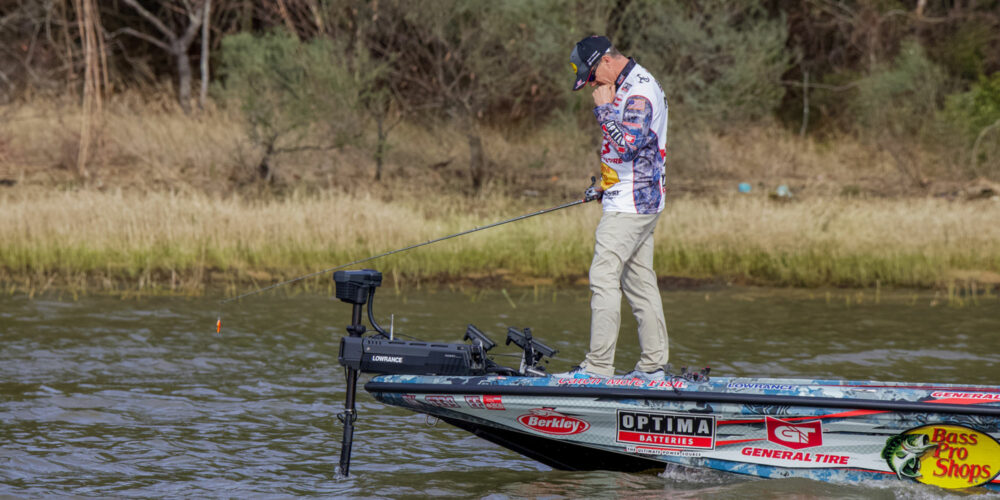EDWIN EVERS: Hit the Hard Spots

In this column, I want to share one of the most underrated postspawn bass patterns. It’s also a pretty advanced bass fishing tip, and if you’ll give it a try and work at it, it’s going to take your postspawn and summer fishing to the next level.
It’s all about fishing “hard spots,” and it’s so good and so important at this time of year that my latest edition of Project E covers it in detail. Check it out to see exactly how I approach this method.
What are “hard spots”? Well, they’re just what you think. When I talk about hard spots, I’m thinking of an area of lake or river bottom — the substrate on your favorite fishery — that’s harder than the area surrounding it. Maybe it’s sand surrounded by decaying vegetation or rock surrounded by mud. It’s usually not just harder than everything around it, but also rougher, often rockier or covered in mussels.
Why is it important? When fish are “looking down” to feed on forage that’s related to the bottom, that forage typically prefers a harder bottom. Crawfish like to hide in rocks. There are times when baitfish like to relate to the bottom and feed on algae. And shell beds are a great example of a harder bottom. Mussels congregate around areas where they can filter feed. Forage and bass follow.
Why is this pattern so good? Because very few anglers know about it or understand how to find these areas. Some don’t have the equipment to do it. For decades, fishing this pattern was hit or miss. Guys would drag a Carolina rig across the bottom or bounce a diving crankbait through an area in hopes of contacting one of these harder bottom areas. They might pull their lures for a lot of miles before they found what they were looking for.
Back in the days of sonar flashers, anglers would drive around with their eyes glued to the screen, but they could only see a narrow cone directly under the boat. With today’s side- and down-imaging technology, we can find these areas quickly and often see just how many fish are down there. Fish related to these hard spots are typically not pressured because they’re away from the shoreline and the thing that’s holding them in the area or bringing them to the area to feed — the hard spot — is so subtle that few anglers are even aware of it.
Hard spots can appear almost anywhere, but you increase your odds of finding them by looking for places where current washes over a high spot, clearing out the sediment that collects on the bottom of older lakes and reservoirs. These high spots don’t have to be much higher than the surrounding area — 6 inches or a foot higher might be enough to keep them clean and free of debris — and they don’t need to be on a drop-off or significant depth change. The hard spot itself can be enough to draw bass if it has a little cover, holds food or it’s that “something different” in the area.
I’ll target hard spots in the prespawn and from about June through September. Using the SideScan on my Lowrance unit, I watch for changes in the palette color on the screen as I move slowly through an area. That change in color indicates a change in bottom composition, and I’ll often see some rocks or other cover associated with it. If I also see fish, I know I’m in business.
Depending upon the body of water and time of year, I look for these hard spots anywhere from about 2 to 20 feet deep — occasionally deeper. When I’m fishing a hard spot in 2 to 7 feet of water, I’m usually going to fish one of three bait types: (1) a lipless crankbait like the Berkley Warpig in a shad pattern, (2) a square bill crankbait like the Berkley SquareBull (also in shad colors) that will dive deep enough to dig into the bottom or (3) a Carolina-rigged worm, shaky head or football jig that I can fish across the spot slowly and thoroughly.
If the water’s deeper, I’ll go to (1) a deep-diving crankbait like the Berkley Dredger series, (2) a soft plastic swimbait like the Berkley PowerBait The Champ Swimmer or (3) a big flutter spoon like the Bass Pro Shops Rattlin’ Nitro Flash Casting Spoon.
Whatever the depth, the fish are typically on these hard spots to feed — or they’re not there at all until they decide to feed — so I work pretty fast. I’ll make a couple of casts with each lure. If I don’t get bit, I’m off to my next spot. But just because a hard spot doesn’t produce at one time doesn’t mean it won’t be great in an hour or two, so consider rotating through these areas over the course of a day. Eventually, you could find yourself catching bass cast after cast!
And don’t forget to check out Project E. In addition to the episode on hard spots, you’ll find lots of other videos that detail how I approach all sorts of bass fishing situations, including flipping and pitching, riprap, bridges, new water and more. Making the series is helping me become a better and more aware angler. I think it can do the same for you.